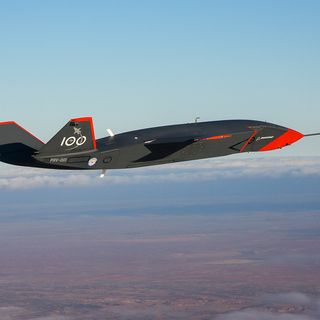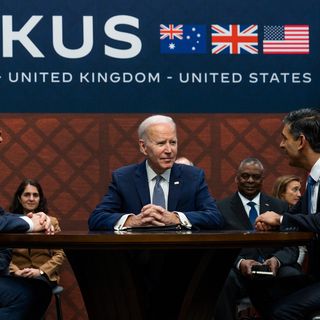With the ‘optimal pathway’ for Australia to acquire nuclear-powered submarines under Pillar I now clear, it is time for a renewed focus on the other half of the AUKUS agreement between Australia, the United States and the United Kingdom: Pillar II advanced capabilities. This explainer provides an update on the eight areas that make up Pillar II of the agreement, and the progress made so far toward the funding and legislation necessary to unlock its potential.
First announced in September 2021, Pillar II began with four areas of technological capability: cyber capabilities (now advanced cyber), artificial intelligence (now artificial intelligence and autonomy), quantum technologies, and additional undersea capabilities. In April 2022, this list expanded to include a further four areas: hypersonic and counter-hypersonic capabilities, electronic warfare, innovation, and information sharing.
As it stands, AUKUS partners have announced that experimentation and demonstrations in four of the eight areas (undersea capabilities, quantum technologies, hypersonics and autonomous systems) will occur before 2025, with a trial of AI and autonomous systems having already taken place in the United Kingdom in early 2023. The timelines for these trials and experimentation suggest that material progress on Pillar II will occur ahead of the sale of the US Virginia-class submarines to Australia and the construction of the first SSN-AUKUS, both of which are expected some time next decade. However, to ensure Pillar II can reach its potential in this timeframe, increased and sustained public engagement will be necessary to leverage and foster the requisite industry and research and development (R&D) partnerships.
As it stands, AUKUS partners have announced that experimentation and demonstrations in four of the eight areas (undersea capabilities, quantum technologies, hypersonics and autonomous systems) will occur before 2025, with a trial of AI and autonomous systems having already taken place in the United Kingdom in early 2023.
Outside of these experimentation and demonstration announcements, various legislative efforts in the United States are yet to deliver the change needed to unlock genuinely trilateral cooperation on advanced capabilities. Funding for Pillar II has also been opaque at best — partner nations have offered different levels of detail and vary by how ‘AUKUS-specific’ they frame their investments.
While national security constraints likely restrict the extent to which progress can be publicly announced, a lack of coordinated public engagement between the three countries on Pillar II progress may prove problematic, given that most of the advancements in Pillar II’s dual-use technologies are likely to take place in industry and academic settings. To ensure the Pillar II enterprise lives up to its potential, public transparency and coordination (to the extent possible) will be key to both ensuring AUKUS delivers on its stated aims and cultivating the industry and research partnerships necessary to ensure its success.

Progress update on the AUKUS Pillar II advanced capabilities
Technological areas
Advanced cyber
Added in September 2021 to strengthen cyber capabilities, including protecting critical communications and operations systems. There have been no public announcements of progress on advanced cyber since, despite some related projects underway (see Funding section).
Artificial intelligence (AI) and autonomy
Emphasised in initial and subsequent joint AUKUS statements to "maintain a capability edge and defend against AI-enabled threats” by “accelerating adoption, and improving the resilience of, autonomous and AI-enabled systems.” In April 2023, AUKUS partners conducted a demonstration trial of AI and Autonomy in the United Kingdom — the first publicly announced, practical demonstration of progress in a Pillar II technological area. This saw two ‘world firsts’ — “the live retraining of models in flight and the interchange of AI models between AUKUS nations” as part of “a collaborative swarm to detect and track military targets...in real time.” In May 2023, the US Department of Defense also requested US$5 million funding for a cloud-based AUKUS AI Hub to support data transfers and “trilateral collaboration within a shared modelling and simulation environment.”
Electronic warfare
This capability was added in April 2022 to focus on improving shared “tools, techniques, and technology to enable our forces to operate in contested and degraded environments.” To date, no other announcements have been made public.
Hypersonics and counter-hypersonics
Highlighted as an advanced capability priority area across the lifetime of AUKUS Pillar II (April 2022, December 2022 and March 2023), including plans for demonstrations in 2023–24 and beyond. This builds on a history of existing US — Australia bilateral collaboration. For example, in 2020 the partners signed an agreement to develop and test hypersonic cruise missile prototypes.
Quantum technologies
Announced at the AUKUS launch, with positioning, navigation and timing listed as the immediate focus in 2022 under the AUKUS Quantum Arrangement (AQuA). Emerging quantum technologies are to be integrated into trials and experimentation in the following three years (by early 2025). However, no clear deliverables have been made public as of mid-2023 about AQuA or broader trilateral quantum technology collaboration.
Undersea capabilities
Announced at the AUKUS launch, with an early 2022 statement emphasising “advanced trilateral maritime undersea intelligence, surveillance, and reconnaissance capabilities” and noting that initial trials and experimentation of the AUKUS Undersea Robotics Autonomous Systems (AURAS) project were planned for 2023 — but nothing further has been publicly announced.
Functional areas
Information sharing
Included in April 2022 to “expand and accelerate sharing of sensitive information...on agreed areas of advanced capabilities.” The importance of robust and novel information sharing was emphasised by the US Secretary of Defense Lloyd Austin in a statement in March 2023.
Innovation
Added in April 2022 as a new Pillar II working group to advance the partners’ respective defence innovation enterprises and promote knowledge sharing, including encouraging more efficient integration of commercial technologies. When Australia’s Advanced Strategic Capabilities Accelerator (ASCA) launched in April 2023, Deputy Prime Minister Richard Marles noted it would play a key role in operationalising AUKUS Pillar II.
ASCA is the only national defence accelerator set up after the AUKUS initiative was announced and as such this observation stands alone. Four of ASCA’s six priority areas are directly relevant to components of Pillar II, these are: hypersonics, trusted autonomy, quantum technology, and information warfare. The program’s first innovation challenge — support for an Australian sovereign uncrewed aerial system (UAS) and trusted autonomy industrial capability — has already been released on tender.
Laying the foundations for AUKUS: Strengthening Australia’s high-tech ecosystem in support of advanced capabilities

Additional developments
Across the six advanced technologies and two functional areas of Pillar II, there have also been developments in areas that are related to AUKUS without being explicitly or formally linked to the agreement — some of which even predate AUKUS. For example, with reference to underwater capabilities, all three nations currently have separate programs to acquire Unmanned Underwater Vehicles (UUVs). While any relationship between these UUV acquisitions and AUKUS is yet to be publicly stated, under its ‘AUKUS Innovation Initiatives,’ the US Department of Defense (DOD) requested funding to “develop payloads to execute specific trilateral missions” for UUVs in 2023. This suggests efforts are in train to coordinate independent UUV initiatives under the banner of AUKUS Pillar II. In addition, Australia, the United Kingdom and the United States have each progressed independent advanced cyber initiatives, but none have been framed or integrated under AUKUS.
Australia has also progressed independent research in hypersonics and counter-hypersonics. In 2022, the Federal Government allocated A$14 million to set up a purpose-built hypersonic research and collaboration facility in Brisbane, with the intention of “supercharging Australian defence research.” The facility is designed to support collaboration between “defence, industry, universities and international partners to advance the development of hypersonic technology.” Australia and the United States also continue to pursue their bilateral hypersonic program (SciFire) without the United Kingdom.
In relation to electronic warfare, all three nations are set to operate the US Airforce E-7 Wedgetail (an electronic warfare platform), which may incentivise cooperation in other AUKUS-relevant initiatives. Meanwhile, AUKUS efforts on the information sharing functional area will build on a strong history of collaboration through the Five Eyes network.
While these ancillary efforts are encouraging, there are signs that a more explicit Pillar II announcement may be on the way. In late August 2023, US Under Secretary of Defense for Research and Engineering, Heidi Shyu, said she expected a presidential announcement on AUKUS sometime in the 2023 Australian spring. Shyu also noted details on the critical technology were being “flushed out” and suggested a “portfolio approach” to rolling out capabilities.
Legislative progress
Progress on Pillar II is encumbered by US export controls, including the International Traffic in Arms Regulations (ITAR) which affects all military acquisition programs and technology transfer. A recent United States Studies Centre report by Tom Corben and Dr William Greenwalt discusses the beleaguered history of Australia’s experiences with ITAR and the barrier these regulations present to the realisation of AUKUS, particularly Pillar II.

In recent months, numerous legislative and reform proposals have been introduced by the White House and across US government departments and various Congressional committees to address AUKUS cooperation challenges. These are summarised below.
White House
A joint statement released after the Australia–United States bilateral leaders meeting in May 2023 announced that President Biden would ask the US Congress to add Australia as a “domestic source” within the Defense Production Act to boost industrial base collaboration and “accelerate and strengthen AUKUS implementation.”
State Department
The State Department Authorization Act of 2023 introduced in June 2023, contained complementary language to the AUKUS Undersea Defense Act introduced in the House of Representatives (below), as well as provisions around advanced clearance for the transfer of AUKUS-related technologies. The next month, July 2023, the State Department introduced the AUKUS Trade Authorization Mechanism. This was described as an interim measure to facilitate trade of US defence articles and services between the AUKUS partners with relevance to both Pillar I and II while more robust solutions work their way through government.
The State Department also released a review of their Foreign Military Sales (FMS) process. This review is primarily concerned with “improving the efficiency and competitiveness of Foreign Military Sales.”
Department of Defense
The DOD released a complementary Foreign Military Sales review which identifies six pressure points and recommends improvements to accelerate internal execution and processing of FMS cases. While neither the State nor Defense Department’s review announcements mentioned AUKUS, both stand to benefit efforts to streamline cooperation on Pillar II.
Congress – House of Representatives
In June 2023, the AUKUS Undersea Defense Act was introduced in the House of Representatives. It aims to provide a pathway towards ITAR exemptions for both Australia and the United Kingdom. The Act also proposes giving the US Secretary of State authority to exempt nations once they have established a standard of export controls “comparable” to that of the United States. In July 2023, the AUKUS Oversight and Accountability (AOA) Act was introduced, which aims to offer a layer of oversight and accountability to the US State Department’s implementation of AUKUS. The same month, the Keeping our Allies Leading in Advancement (KOALA) Act was also introduced, proposing export control and defence article exceptions and modifications for Australia. Finally, the Bilateral Resilience in Industry Trade Security (BRITS) Act was also introduced, proposing export control and defence article exceptions and modifications for the United Kingdom. The introduction of separate pieces of legislation to deal with Australian and UK legislative change suggests Congress is anticipating objections to giving both countries co-equal exemptions.
Congress – Senate
The TORPEDO Act was announced by the Senate in May 2023. In addition to containing similar language to President Biden’s request to add Australia as a “domestic source” to Congress, the TORPEDO Act also calls for: expedited export and reexport processes of US defence dual-use and other controlled items to AUKUS partners; the creation of a fast-tracked Foreign Military Sales process for Australia and the United Kingdom; reduced barriers to information sharing; changes to partner export control regimes; and the appointment of an AUKUS Senior Advisor.
At time of writing, the Senate and House are reconciling their versions of the FY 2024 National Defence Authorization Act (NDAA). Both versions of the bill contain language which bodes well for the expediated transfer of defence articles and services to successfully implement AUKUS. The impressive legislative effort of the past few months suggests US interlocutors recognise the impediments US export controls place on AUKUS Pillar II. Some members of the Senate Committee on Foreign Relations demonstrated this plainly at a recent Senate hearing on AUKUS. In particular, Senator James Risch noted “demands from the Administration that Australia and the UK undertake extensive reform of their domestic and regulatory systems are frankly condescending and highlights the need for a clear shift in [the Department of] State’s attitude toward defence cooperation with our allies.” Senator Risch also urged consideration of “how we treat our allies in the intelligence field [to] make it more compatible with how we treat them in trade…matters.”
This language and the introduction of numerous legislative items is a positive sign for progress on Pillar II and defence industrial collaboration more generally. However, lingering concerns of some groups within Congress and the State Department about the capacity of the Australian and British governments to protect US technology remains a cloud over Pillar II collaboration.

Funding Pillar II
In contrast with the clearer funding components of Pillar I, details on the funding for the composite areas and capabilities of AUKUS Pillar II are opaque at best. Instead, pools of funding have been announced by AUKUS countries — varying in detail and whether respective governments have labelled them as AUKUS-specific or AUKUS-tangential investments. To date, the US DOD has released the most detailed line-item funding for Pillar II projects as part of its budget process, whereas Australia has only offered headline figures and the United Kingdom is yet to announce any funding linked to Pillar II.
Australia's FY2023–24 Federal Budget committed A$151.6 million over the next four years to AUKUS Pillar II as part of the broader A$900 million for ‘defence innovation’, to compliment the A$748 million of reappropriated funding dedicated to the recently launched ASCA. As of August 2023, no further detail has come to light as to how this A$151.6 million will be spent.
In contrast with Australia’s yet-to-be-defined allocation of spending for Pillar II, in the United States the DOD requested US$25 million in its FY2024 Budget Estimates for five specific AUKUS ‘Innovation Initiatives’. Three of these clearly sit within Pillar II technological areas — funding for a cloud-based AUKUS Artificial Intelligence (AI) development hub (US$5 million), payloads for UUVs in trilateral missions (US$10 million), and US$6 million to purchase commercial space data in support of a cyber capability development. The other two initiatives — another US$1 million for commercial space data for an ‘enhancing battlespace awareness’ project and US$3 million for engineering and architecture studies — do not clearly line up with specific AUKUS areas. Interestingly, the request to purchase space data is specifically for incorporation into an “existing project” yet no other details are public about this project or where it fits within the AUKUS framework. The funding of these five AUKUS-specific initiatives is justified to pursue “operationally relevant advanced capability co-development [to] support integration of multi-national capabilities...and test and evaluate promising solutions from across the AUKUS innovation ecosystem.” The US DOD also emphasises these proposals are the result of a “merit-based process that identifies the most promising solutions to operational challenges” facing AUKUS nations.
To date, there have been no Pillar II-specific funding announcements from the UK Government. However, they did announce the Advanced Research and Invention Agency (ARIA) in February 2021, an independent body promoting 'high-risk, high-reward scientific research' with funding of £800 million across five years. ARIA, alongside DARPA, was a model for Australia’s recently launched AUKUS-linked ASCA. However, to date no public comments by the UK Government have linked ARIA to AUKUS, despite the parallels in focus and the Australian Government referencing collaboration with the United States’ DARPA and the United Kingdom’s ARIA under AUKUS as part of the rationale for ASCA.
Unlike security alliances, such as NATO, that leverage joint or common funds to finance collaborative defence technology development, AUKUS Pillar II funding commitments have not been coordinated or advertised heavily in public.
Unlike security alliances, such as NATO, that leverage joint or common funds to finance collaborative defence technology development, AUKUS Pillar II funding commitments have not been coordinated or advertised heavily in public. Each partner government varies regarding the degree of detail released, and the degree to which they explicitly link the funding itself to AUKUS. While transparency may improve over time, the national security sensitivities around funding for dual-use technologies, and complex bureaucratic processes, will likely prevent Pillar II from ever having the same clear-cut headline funding figure of Pillar I.
Conclusion
To date, recorded progress on cooperation and development, US legislative reform, and funding highlights the considerable hurdles that lay ahead of the ‘quick wins’ envisaged by Pillar II’s most ardent supporters. Notwithstanding this, the numerous US legislative attempts to address barriers to the success of AUKUS are a promising sign for future collaboration. Furthermore, progress on trials, including in AI and automation, and initial funding commitments — sporadic as their public disclosures may be — are encouraging preliminary signals.
Despite this progress, engagement with industry, the R&D community and the broader public will be key to achieving Pillar II’s goal of fostering trilateral collaboration across various dual-use technological areas — particularly given that innovation in these technologies largely occurs outside of government. To date, engagement across these groups has largely been found wanting. Consistent public statements, updates and announcements on AUKUS Pillar II would not only offer opportunities to promote deterrence but would enable the AUKUS partners to take better advantage of academic and industry engagement opportunities and aid coordination across a complex set of defence, innovation and bureaucratic ecosystems. If Australia, the United States, and the United Kingdom are able to remove the barriers to the latter they might just transform their trilateral cooperation in a way that outlives the timeline of the AUKUS enterprise.







